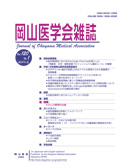

Journal of Okayama Medical Association
Published by Okayama Medical Association<Availability>
Full-text articles are available 3 years after publication.
Permalink : http://escholarship.lib.okayama-u.ac.jp/19404
Studies on Cholinesterase in the Infants with Disease of the Nervous System Part 2. A Study on the Tissue Cholinesterase in Suckling Mice infected with Virus
Egusa, Yasuhiko
Published Date
1959-04-15
Abstract
With the purpose to know the significance of the changes in the tissue cholinesterase (Ch E) occurring in the viral infection, the author inoculated to suckling mice either singly or in various combinations such viruses as Coxsackie group A type-2, type-19, group B type 1, poliovirus, the Lansing strain, and the mousel-adapted Mahoney and Leon strains; and studied the fluctuations in Ch E of the brain, spine and muscles by Warburg's techniques. As the result it has been found that tissue Ch E values roughly coincide with histological findings and clinical symptoms of the infected mice. 1. The Ch E value of the brain and spine in the normal suckling mice is 72.0±6.6 and that of muscles is 42.5±6.5. 2. In consideration of the changes in the Ch E of the brain, spine and muscles to be brought about by virus invasion, the emulsion of muscles from normal suckling mice is inoculated into other normal suckling mice and the Ch E values are estimated. These values are taken as the control. The ChE value of the brain and spine is 59.7±10.2, 17 per cent less than that in normal suckling mice; while the Ch E of the muscles is 41.±2.6, showing no difference from the control. Such changes in the range of 5 per cent error can not be construed as a significant difference. 3. The ChE values of the brain and spine in the suckling mice inoculated with the gronp A-type2 of Coxsackie virus or with the type 19 do not differ from the control, and the ChE of the muscles in the animals inoculated with the type 19 is 19.5 per cent less than the control, stochastically showing no significant difference. In the animals inoculated with the group B-type 2 the ChE value of the brain and spine is decreased by 23.9 par cent, and this shows a significant difference from the control in the range of 5 per cent error. However, no difference can be observed in the ChE of the muscles as compared with the control. Moreover, the changes in the tissue ChE approximately coincide with histological findings. 4. In the group inoculated with poliovirus, conversely to the group inoculated with the Coxsackie strain, the ChE of the brain and spine in the suckling mice showing the symptoms of disease by the inoculation of the Lansing strain presents a marked increase of 56.8 per cent, while in those inoculated with the mouse-adapted Mahoney and Leon strains but showing no symptoms of disease the ChE values of the brain and spine rather show a decreasing tendency. In addition, the ChE of the muscle show no difference from the control. 5. In the group inoculated with both Coxsackie and polio viruses an interferance phenomenon can be observed, while in the group inoculated with the Lansing and Okumoto strains (A-22) the ChE values show no marked increase such as observable in the group inoculated singly wirh the Lansing strain, and showing only the increase of 12.3 per cent in the ChE of the brain and spine, but the value, fluctuating within the normal range, can not be said to show any significant difference from the control. Other group given inoculation of Coxsackie combined with poliovirus tend to show the decrease of 10.9 per cent to 18.1 per cent. As for the ChE of muscle the group inoculated with both Mahoney and Dohi strains (A-19) a decrease of 13 per cent can be seen. Still other groups given different sets of inoculation show a slightly increasing tendency. All these values in the range of 5 per cent error, however, can not be considered to present any significant differences.
ISSN
0030-1558
NCID
AN00032489
